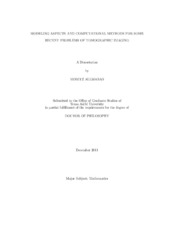| dc.description.abstract | In this dissertation, two recent problems from tomographic imaging are studied, and results from numerical simulations with synthetic data are presented.
The first part deals with ultrasound modulated optical tomography, a method for imaging interior optical properties of partially translucent media that combines optical contrast with ultrasound resolution. The primary application is the optical imaging of soft tissue, for which scattering and absorption rates contain important functional and structural information about the physiological state of tissue cells. We developed a mathematical model based on the diffusion approximation for photon propagation in highly scattering media. Simple reconstruction schemes for recovering optical absorption rates from boundary measurements with focused ultrasound are presented. We show numerical reconstructions from synthetic data generated for mathematical absorption phantoms. The results indicate that high resolution imaging with quantitatively correct values of absorption is possible. Synthetic focusing techniques are suggested that allow reconstruction from measurements with certain types of non-focused ultrasound signals. A preliminary stability analysis for a linearized model is given that provides an initial explanation for the observed stability of reconstruction.
In the second part, backprojection schemes are proposed for the detection of small amounts of highly enriched nuclear material inside 3D volumes. These schemes rely on the geometrically singular structure that small radioactive sources represent, compared to natural background radiation. The details of the detection problem are explained, and two types of measurements, collimated and Compton-type measurements, are discussed. Computationally, we implemented backprojection by counting the number of particle trajectories intersecting each voxel of a regular rectangular grid covering the domain of detection. For collimated measurements, we derived confidence estimates indicating when voxel trajectory counts are deviating significantly from what is expected from background radiation. Monte Carlo simulations of random background radiation confirm the estimated confidence values. Numerical results for backprojection applied to synthetic measurements are shown that indicate that small sources can be detected for signal-to-noise ratios as low as 0.1%. | en |


